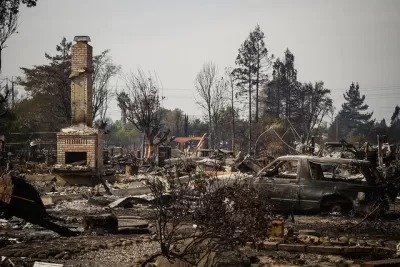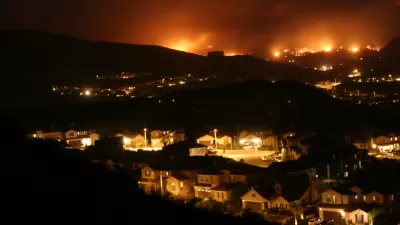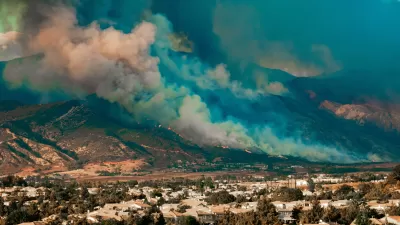With the state of California in the grips of its most destructive year of wildfires ever, policy makers are pondering questions about whether it is appropriate to rebuild in places at high risk of burning again.

"With the frequency and cost of catastrophic wildfires climbing in California, the idea of compensating property owners to not rebuild — or using economic pressure to discourage them from building in the first place — is gaining supporters among those searching for ways to cut wildfire losses," according to an article by Doug Smith.
While some policy makers and academics have proposed measures that would control the scale to which the state rebuilds in areas that have already burned, or builds new in places likely to build in the future, there are many policies in place in California that expedite rebuilding. Many in favor of rebuilding point out that new houses built to replace houses that burnt down in the fire would be built to much higher standards of fire resistance. Meanwhile, those who say the state shouldn't continue to build in fire danger areas, say a "three-strikes" rule or public land acquisition programs should be implemented around the state.
There's also the ongoing question of how to predict future fires, which was explained by an earlier Planetizen post by Katharine Jose. Along those lines, Jones reports that Cal Fire plans to revise its fire prediction maps, "[i]n light of experience showing that wind-blown embers can carry fire into suburban areas."
FULL STORY: After California's most destructive fire season, a debate over where to rebuild homes

Manufactured Crisis: Losing the Nation’s Largest Source of Unsubsidized Affordable Housing
Manufactured housing communities have long been an affordable housing option for millions of people living in the U.S., but that affordability is disappearing rapidly. How did we get here?

Americans May Be Stuck — But Why?
Americans are moving a lot less than they once did, and that is a problem. While Yoni Applebaum, in his highly-publicized article Stuck, gets the reasons badly wrong, it's still important to ask: why are we moving so much less than before?

Using Old Oil and Gas Wells for Green Energy Storage
Penn State researchers have found that repurposing abandoned oil and gas wells for geothermal-assisted compressed-air energy storage can boost efficiency, reduce environmental risks, and support clean energy and job transitions.

Minneapolis Bans Rent-Setting Software
Four cities have enacted restrictions on algorithmic software that can inflate rent costs.

Oakland to Add 244 New EV Chargers
Oakland plans to launch its new charging network at eight locations by the end of 2025.

Jane Goodall Inspires with Message of Hope, Resilience, and Environmental Action
Speaking in Pasadena, Jane Goodall offered a hopeful and inspirational message, urging global compassion, environmental responsibility, and the power of individual action to shape a better future.
Urban Design for Planners 1: Software Tools
This six-course series explores essential urban design concepts using open source software and equips planners with the tools they need to participate fully in the urban design process.
Planning for Universal Design
Learn the tools for implementing Universal Design in planning regulations.
Heyer Gruel & Associates PA
City of Moreno Valley
Institute for Housing and Urban Development Studies (IHS)
City of Grandview
Harvard GSD Executive Education
Salt Lake City
NYU Wagner Graduate School of Public Service
City of Cambridge, Maryland





























